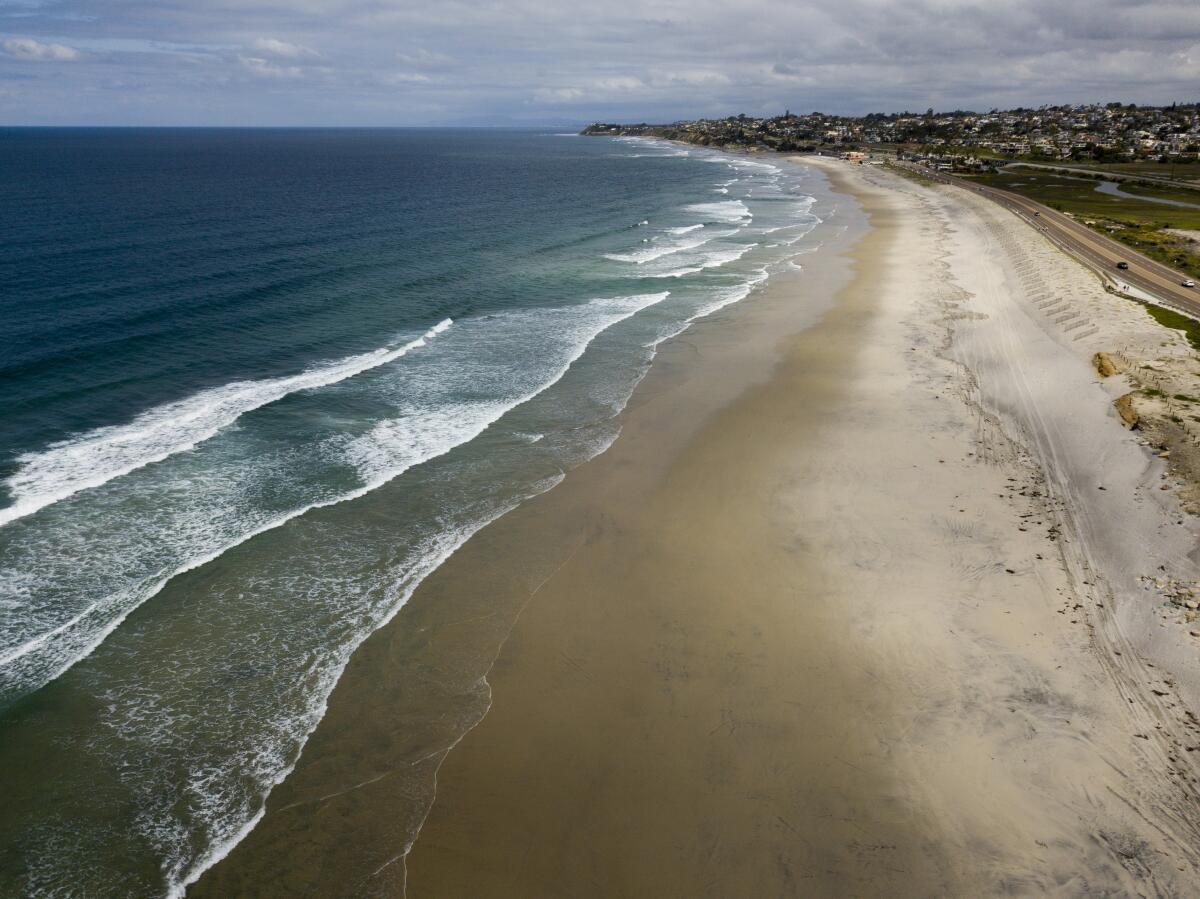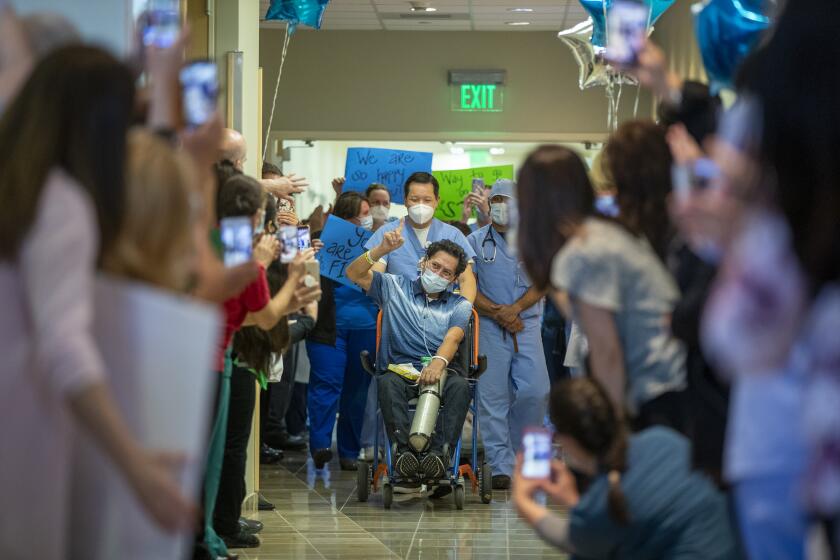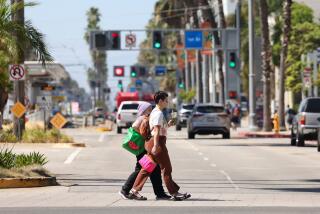Is there a greater risk of coronavirus spread at the beach? Scientists aren’t sure

- Share via
For weeks, a debate has been raging over whether going to the beach or swimming in the ocean increases your risk of catching or transmitting the coronavirus. The issue has rankled surfers, overwhelmed runners and bikers and confused anyone seeking the fresh air and freedom of California’s coast.
So when a scientist last week suggested sea spray could possibly expose people to the virus, the controversy just exploded.
Now, after virulent criticism as well as new and rapidly developing information about the pathogen, the researcher is reassessing this hypothesis.
Kim Prather, an atmospheric chemist at the Scripps Institution of Oceanography, said she still believes there is potential for viral particles to travel farther than six feet in breezy air along beaches, but that new research suggests ocean water may be no more dangerous than it was before the pandemic.
“At this point, there is not enough known about this virus to draw any different conclusions from the long-standing recommendation to avoid swimming and surfing in regions where the ocean is polluted and check local beach water quality before heading to the beach,” Prather said this week.
“However, communal spread of SARS-CoV-2 at crowded beaches remains an issue,” she said, “especially given recent assessment on the potential aerosolization of this virus in smaller particles which may travel more than the six feet that social distancing guidelines suggest.”
These are some of the unusual new scenes across the Southland during the coronavirus outbreak.
In a Los Angeles Times interview early last week, Prather was quoted as saying, “I wouldn’t go in the water if you paid me $1 million right now.” She posited that SARS-CoV-2, the virus that causes COVID-19, could enter the ocean — through raw or poorly treated sewage — and then get kicked back into the air along the surf zone.
But new research published after the interview has changed her thinking. The research includes an accelerated publication of a study in the journal Nature, which found that the virus did not appear to remain infectious in fecal matter.
“The main exposure risk to the water recreation community remains sewage pollution and urban runoff into the ocean, which can increase after major storms such as what we had this week,” Prather said in a follow-up interview this week. “The health effects of exposure to polluted waters have been the focus of numerous studies and the risks are well documented; less clear are the effects of exposure to aerosols produced in sea spray from the polluted ocean. Clearly, more research is needed on this particular virus to determine whether it loses infectiousness through sewage treatment and exposure to air, sunlight, and water.”
Prather’s comments last week, which were intended to serve as a precaution to beachgoers, ignited a firestorm of controversy — particularly among surfers, who were already locked in a heated debate over whether they should continue surfing amid stay-at-home orders. In emails and online comments, writers accused her of stoking fear and hysteria. They bashed Prather as a scientist and as a woman and hurled obscenities, crude insults and, in some cases, threatening language.
In a world that has grown used to finding immediate answers to questions on the internet, the inability of scientists to offer conclusive answers to such seemingly simple questions as “is it safe to go in the water” has added more frustration and anxiety to lives turned upside down by the pandemic. Although research into SARS-CoV-2 is moving at breakneck speed, insecurity over the future can generate anger and distrust, experts say.
“You get this situation that is totally unprecedented, and people really don’t know what’s going on, it’s changing day to day — what we thought was true two months ago is clearly not how we’re seeing things now — and it just creates this perfect storm of distrust, and it’s coming from a place of fear,” said Vaile Wright, the American Psychological Assn.’s director of clinical research and quality, who explained that the range of reactions also depends on a person’s ability to tolerate or not tolerate uncertainty.
“A way of dispelling that frustration or that fear is to attack,” she said. “Those who are really intolerant of uncertainty are feeling incredibly threatened, incredibly vulnerable right now — they often view this whole situation as unfair.”
Even for herself, Wright said it has been difficult to know what are appropriate actions to take, and what’s going too far.
“We, as humans, prefer answers to questions,” she said, “opposed to the ambiguity that we’re seeing right now.”
Indeed, scientists are still investigating the basic characteristics of the virus and the news has been evolving at overwhelming speed. In just one week, the nation went from being told that face masks were unnecessary for those not in healthcare, to a national advisory to wear basic cloth masks, to the mayor of Los Angeles urging all residents to cover their face when out in public.
And this week, people in Los Angeles are being asked not to leave their homes at all if possible, even for groceries, as the virus continues to spread.
Jennifer Savage, Surfrider Foundation’s policy manager in California, said the pace of new information has been remarkable. The group itself recently shifted its messaging based on the latest guidance and science — going from urging social distancing measures when at the beach to just staying home for the greater protection of the community. Last week, they launched their #StayHomeShredLater campaign.
Savage said many folks have supported this new message, but acknowledged that the crisis has upended people’s relationship with the outdoors. The ocean, in particular, is considered calming and restorative, she said, and to now be “told that no, in fact, it could be a place where you could be potentially at risk or potentially putting other people at risk — it’s just contrary to everything that we instinctively feel.”
“It seems like every day is bringing new restrictions, and everyone is just so vulnerable right now — not just with health but with the economic future,” Savage said, “and so to be told that here is the one place that you find peace and freedom from all of that. ... It’s a very human thing to blame the messenger.”
Prather, who directs the Center for Aerosol Impacts on Chemistry of the Environment, said that people should still be mindful at the beach — especially if, as the latest information indicates, the virus could be airborne and travel much farther than six feet.
Just last week, the National Academies of Sciences, Engineering, and Medicine sent a “rapid expert consultation” letter to the White House advising that SARS-CoV-2 could be spread via bioaerosols generated directly by normal breathing and speaking, in addition to sneeze- and cough-induced droplets.
“At this point, the virus has not been detected in the ocean or outdoor air, and studies on the waterborne and airborne transmission of this virus are just beginning,” Prather said. “... However, given that there are so many things we do not yet know about the behavior of this virus, it is important that everyone takes extra precautions.“
Is it safe to have sex with my partner or with a person I met on Tinder? Can I pick my nose at home? Do I need to disinfect my groceries? A virologist answers.
Hoping to fill some of these data gaps, Prather plans to measure pathogens in seawater and in the air along the San Diego coast and determine which, if any, become airborne in the atmosphere above areas of the coast where sewage and runoff occur. Past research has shown that certain types of bacteria and viruses get transferred from the ocean into the atmosphere when waves break.
“I believe the most useful messages right now are: stay home, save lives. Keep your distance,” Prather said. “Six feet might not be enough if you are near someone who is infected.”
More to Read
Sign up for Essential California
The most important California stories and recommendations in your inbox every morning.
You may occasionally receive promotional content from the Los Angeles Times.
















